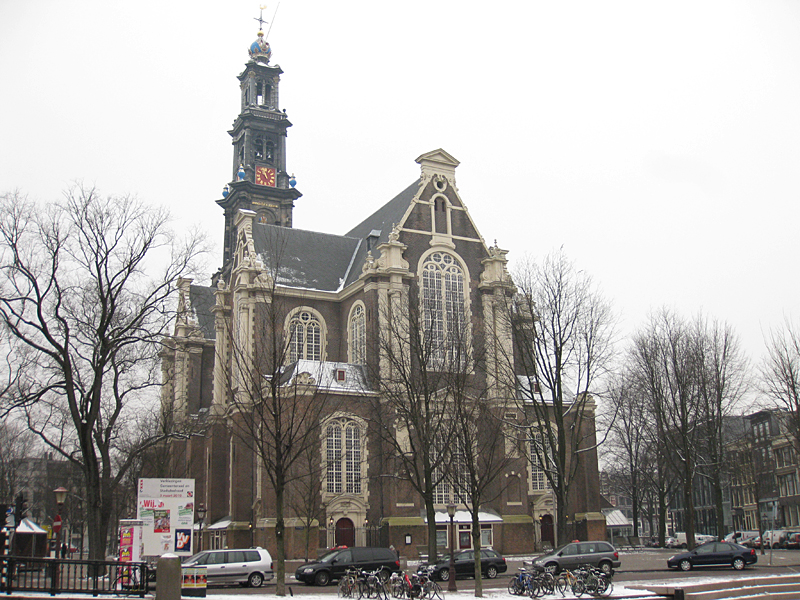Self-guided City Walk along Prinsengracht Amsterdam
A self-guided walk along Prinsengracht in Amsterdam is an afternoon well spent. This canal is named after William of Orange, forefather of the Dutch Royal family. The canal is crisscrossed by shopping streets and lined with charming cafes and canal houses with ornate gables. On the way you can go shopping on the Noordermarkt, experience peace and quiet in hofjes, see the house where Anne Frank went into hiding and have the opportunity to visit the Tulip Museum.

Direction Self-guided City Walk Prinsengracht
START: Noordermarkt.
FINISH: Leidsestraat
1. The self-guided walk Prinsengracht starts at Noordermarkt
Noordermarkt is dominated by Noorderkerk, North Church, a massive bulk of brick. It is difficult to imagine that this church was designed by Hendrik de Keyser, the same architect who created the elegant Westerkerk. On Monday morning from 09.00-14.00 and on Saturdays from 09.00-16.00, Noordermarkt turns into a colourful, open-air market. Stock up on oriental rugs, sunglasses, posters or paintings and everything at affordable prices.
2. At the end of Noordermarkt turn right and walk along Prinsengracht. Keep the canal on your right and stop at No 36.
Look high up at its elegant neck-gable, pilasters and pediment. This house dates back to mid-17th century. In those days house numbers had not been invented yet. Wall tablet were used instead. No 36 was known as Veersack, sack with feathers. The first owners probably sold bed linen and quilts.

3. Cross the canal and turn left for Hofje van Brienen at Prinsengracht Nos 85-133.
Hofjes are leafy courtyards lined by pretty houses with serene gardens. Most Amsterdam hofjes were built towards the end of 16th century by wealthy protestant merchants. Up till then the Catholic Church had provided subsidized housing for the poor and elderly. However, when Amsterdam no longer sided with Catholic Spain, Catholic churches were forbidden and providing for the poor stopped. Rich Protestant merchants took over the role of looking after the poor. They built the hofjes or almshouses, often to their own glory.
Prinsengracht No 175
Look at the seventeenth-century step-gable and the three wall tablets: a sheep, an ox and a lamb.
Prinsengracht Nos 187-195 and 211-217
The red shuttered windows of the warehouses along Prinsengracht look like an advent calendar. Shutters and hatches are typical of seventeenth-century Amsterdam, when trade flourished and goods arrived on barges. The warehouses have been converted into chic apartments.

4. Retrace your steps, keep the canal on your right until you get to No 263 Anne Frankhuis.
This is the house where the Frank family went into hiding from July 1942 until August 1944. If you want to visit the Anne Frankhuis museum you will have to buy tickets online with a time slot. You will enter the museum via a modern reception area. Anne herself walked up a narrow, steep staircase, through her father’s office and then on to the unused rear part of the building; the back house. A filing cabinet concealed a secret door this part of the canal house. You will see the room where the family sat together and also Anne’s bedroom where she wrote her diary.

5. Continue Prinsengracht on to Westerkerk
Westerkerk, West Church, is topped by the imperial crown of Hapsburg Emperor Maximillian. The clock tower soars 85m (278ft) up into the sky and is Amsterdam’s tallest building. At the corner of Prinsengracht and Westermarkt stands a bronze statue of Anne Frank. It captures Anne’s personality as we know it from her diary. With hands on her back she looks up, full of hope.
Westermarkt No 6
This is an attractive house with an elegant neck gable and a fanlight. The French philosopher, Rene Descartes, lived here for twenty years in the early seventeenth century. Embedded in the pavement of Westermarkt is the Homo Monument, a pink granite triangle commemorating all gays and lesbians who died during Nazi occupation.

6. Opposite Anne Frankhuis, Prinsengracht No 116, is the Amsterdam Tulip Museum
When entering the museum a kaleidoscope of colours greets you. The tulip museum is both flower shop and museum. Get a lesson in the history of the tulip. They are the best Dutch export articles, but they are not endemic. Learn how the tulip was brought to the Netherlands from central Asia via Istanbul and how the tulip became an object of speculation in the 17th century. The museum’s video allows you a view of colourful tulip fields and takes you on a tour of a modern tulip farm.

Prinsengracht 296
Two bridges further down, opposite Berenstraat you will find the Houseboat Museum. Houseboats were the solution to the 1950s housing shortage and are still popular today. Inside you will find everything an ordinary apartment offers but just one a smaller scale.
Prinsengracht 436
Walk on until you get to No 436. This monumental Neo-classical mansion housed the city’s orphanage, but is now court of appeal.
Prinsengracht Nos 855-899
Hofje. Deutzenhofje is behind the imposing front of the houses at Nos 855–899. It was founded by Agneta van Deutz. Flanked by two cherubs and the coat-of arms of her two husbands, the memorial above the entrance reads,
‘Agneta Deutz shows love and devoutness, consolation for the poor and an example for the rich.’
In spite of these pious words, Agneta was a lady to be reckoned with. She built this hofje to rob her spendthrift son from a handsome inheritance.
7. Turn left into Leidsestraat.
Leidsestraat is one of the main shopping streets in Amsterdam.
END OF PRINSENGRACHT CITY WALK
Further reading:
Anne Frankhuis where she wrote her diary
Westerkerk and Anne Frank



